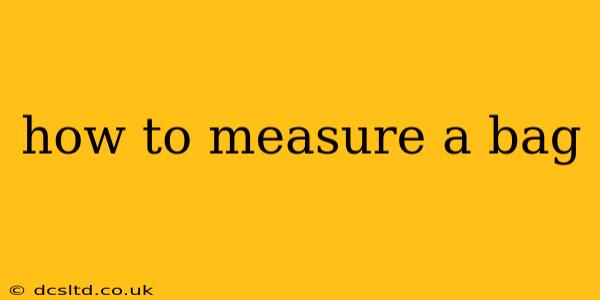Measuring a bag accurately is crucial for various reasons, from ensuring it fits in your overhead compartment to determining its shipping costs or simply finding the perfect size for your needs. This guide will walk you through different methods and considerations for measuring bags of all shapes and sizes.
What are the Standard Measurements of a Bag?
Before you start measuring, it's important to understand what dimensions are typically required. Most commonly, you'll need three measurements:
- Length: The longest distance across the bag, typically measured along the bottom.
- Width: The shortest distance across the bag, typically measured along the bottom.
- Height: The vertical distance from the bottom to the top of the bag.
Some situations may require additional measurements, such as the depth of a pocket or the length of a strap. Always clarify what measurements are required before you begin.
How to Measure a Bag: A Step-by-Step Guide
Here's a detailed method for accurately measuring your bag, irrespective of its shape:
-
Choose your tools: You'll need a flexible tape measure (a soft one is ideal to contour to the bag's shape) and a pen or pencil to record your measurements. A ruler can be helpful for smaller, more precise measurements.
-
Lay the bag flat: Place the bag on a flat, level surface. This ensures accurate measurements and prevents distortions.
-
Measure the length: Extend the tape measure along the longest side of the bag's base. Record the measurement in inches or centimeters.
-
Measure the width: Extend the tape measure along the shortest side of the bag's base, perpendicular to the length measurement. Record this measurement.
-
Measure the height: Starting from the bottom of the bag, extend the tape measure vertically to the highest point. Record this height.
-
Record all measurements: Write down the length, width, and height in a consistent unit (inches or centimeters). If necessary, also record any other relevant measurements like strap length or pocket dimensions.
What if my bag is an unusual shape?
Measuring unusually shaped bags (like cylindrical duffel bags or oddly shaped backpacks) requires a slightly different approach. You might need to take multiple measurements at different points to capture the bag's overall dimensions accurately. Consider measuring the widest and narrowest points, as well as the average height.
How to Measure a Bag for Airline Carry-On Requirements?
Airlines have specific size restrictions for carry-on luggage. Always check the specific dimensions allowed by your airline before you travel. These regulations can vary considerably, even between flights of the same airline. When measuring for carry-on compliance, adhere strictly to the airline's guidelines. It’s better to err on the side of caution.
How to Measure a Bag for Shipping?
Shipping carriers also have size and weight restrictions. Similar to airline carry-on requirements, you must consult the shipping carrier's guidelines before you ship your bag. Inaccurate measurements could lead to delays or additional charges. Ensure your measurements account for the packaging as well, if applicable.
What are the common mistakes to avoid when measuring a bag?
- Not using a flat surface: Measuring on an uneven surface leads to inaccurate readings.
- Pulling the tape measure too tightly: This will result in smaller than actual measurements.
- Not recording measurements clearly: Ambiguous notations can cause confusion later on.
- Failing to check airline or shipping guidelines: This could lead to significant issues during travel or shipping.
By following these steps and paying close attention to detail, you can accurately measure your bag for any purpose. Remember to always double-check your measurements to ensure accuracy and avoid any unexpected problems.
